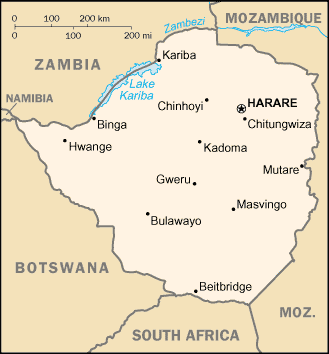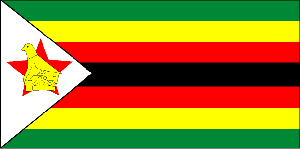
|
Zimbabwe
Background:
The UK annexed Southern Rhodesia from the South Africa Company in
1923. A 1961 constitution was formulated that favored whites in power. In 1965
the government unilaterally declared its independence, but the UK did not
recognize the act and demanded more complete voting rights for the black
African majority in the country (then called Rhodesia). UN sanctions and a
guerrilla uprising finally led to free elections in 1979 and independence (as
Zimbabwe) in 1980. Robert Mugabe, the nation's first prime minister, has been
the country's only ruler (as president since 1987) and has dominated the
country's political system since independence.
1990.
Location:
Southern Africa, between South Africa and Zambia
Area: Total: 390,580 sq km water: 3,910 sq km land: 386,670 sq km
Area - comparative: Slightly larger than Montana
Land boundaries: Total: 3,066 km border countries: Botswana 813 km, Mozambique
1,231 km, South Africa 225 km, Zambia 797 km
Climate and Terrain:
Climate: Tropical; moderated by altitude; rainy season (November to March)
Terrain: Mostly high plateau with higher central plateau (high veld); mountains
in east
People:
Population: 11,376,676
Ethnic groups: African 98% (Shona 82%, Ndebele 14%, other 2%), mixed and Asian
1%, white less than 1% .
Religions: syncretic (part Christian, part indigenous beliefs) 50%, Christian
25%, indigenous beliefs 24%, Muslim and other 1%.
Languages: English (official), Shona, Sindebele (the language of the Ndebele,
sometimes called Ndebele), numerous but minor tribal dialects.
Government:
Government type: Parliamentary democracy.
Capital: Harare.
Independence: 18 April 1980 (from UK).
Economy overview:
The government of Zimbabwe faces a wide variety of
difficult economic problems as it struggles to consolidate earlier moves to
develop a market-oriented economy. Its involvement in the war in the Democratic
Republic of the Congo, for example, has already drained hundreds of millions of
dollars from the economy. Badly needed support from the IMF has been suspended
because of the country's failure to meet budgetary goals. Inflation rose from
an annual rate of 32% in 1998 to 59% in 1999, to 60% in 2000, and to 100% by
yearend 2001. The economy is being steadily weakened by excessive government
deficits, AIDS, and rampant inflation.
Statistics:
Telephones - main lines in use: 212,000 (in addition, there are about 20,000
fixed telephones in wireless local loop connections).
Telephones - mobile cellular: 111,000.
Radio broadcast stations: AM 7, FM 20.
Radios: 1.14 million.
Television broadcast stations: 16.
Televisions: 370,000.
Internet users: 30,000.
Railways: Total: 3,077 km.
Highways: Total: 18,338 km paved: 8,692 km unpaved: 9,646 km.
Airports - with paved runways: 17, with unpaved runways: 437.
Return to Visiting Locations
|

